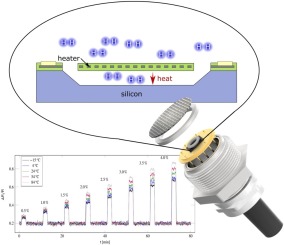Sensors and Actuators A: Physical ( IF 4.6 ) Pub Date : 2019-12-31 , DOI: 10.1016/j.sna.2019.111670 Dominik Berndt , Josef Muggli , Franz Wittwer , Christoph Langer , Stephan Heinrich , Thorsten Knittel , Rupert Schreiner

|
Accurate detection of hydrogen gas in vehicle interiors is very important for the future of a fuel cell car. Since this type of gas is highly volatile and flammable, the measurement methods have to be very reliable and precise due to safety reasons. In this paper a thermal conductivity sensor for hydrogen gas detection is presented, exhibiting a lower detection limit of 2000 ppm hydrogen in laboratory air. The sensor element is realized by micro-fabrication techniques on silicon wafers. The heated filament is exposed by a selective wet etching process creating a micro-hotplate on a thin membrane. In order to minimize power consumption, the sensor is operated in pulsed mode. Hydrogen gas detection was carried out using a synthetic gas testbench. Measurements of hydrogen contents ranging from 0% to 4% with an increment of 0.5% were successfully performed for ambient gas temperatures between C and C. Including humidity, high moisture contents have the greatest influence on thermal conductivity. This was predicted in theoretical investigations and confirmed in experiments. For evaluation, both the change in resistance as well as the time constant were taken as sensor output. For both quantities, the previously established theoretical relationship with thermal conductivity could be confirmed.
中文翻译:

基于MEMS的热导率传感器,用于汽车应用中的氢气检测
准确检测车辆内部的氢气对于燃料电池汽车的未来非常重要。由于这类气体具有高挥发性和易燃性,因此出于安全原因,测量方法必须非常可靠和精确。本文介绍了一种用于氢气检测的热导率传感器,该传感器在实验室空气中的氢气检出限较低,为2000 ppm。传感器元件是通过微制造技术在硅片上实现的。加热的灯丝通过选择性湿法刻蚀工艺暴露,从而在薄膜上形成微热板。为了最小化功耗,传感器以脉冲模式运行。使用合成气测试台进行氢气检测。氢含量的测量范围为0%至4%,增量为0。C和 C.包括湿度在内,高水分含量对热导率的影响最大。这在理论研究中得到了预测,并在实验中得到了证实。为了评估,电阻的变化 以及时间常数 被当作传感器输出。对于这两个量,都可以确认先前建立的与导热率的理论关系。



























 京公网安备 11010802027423号
京公网安备 11010802027423号